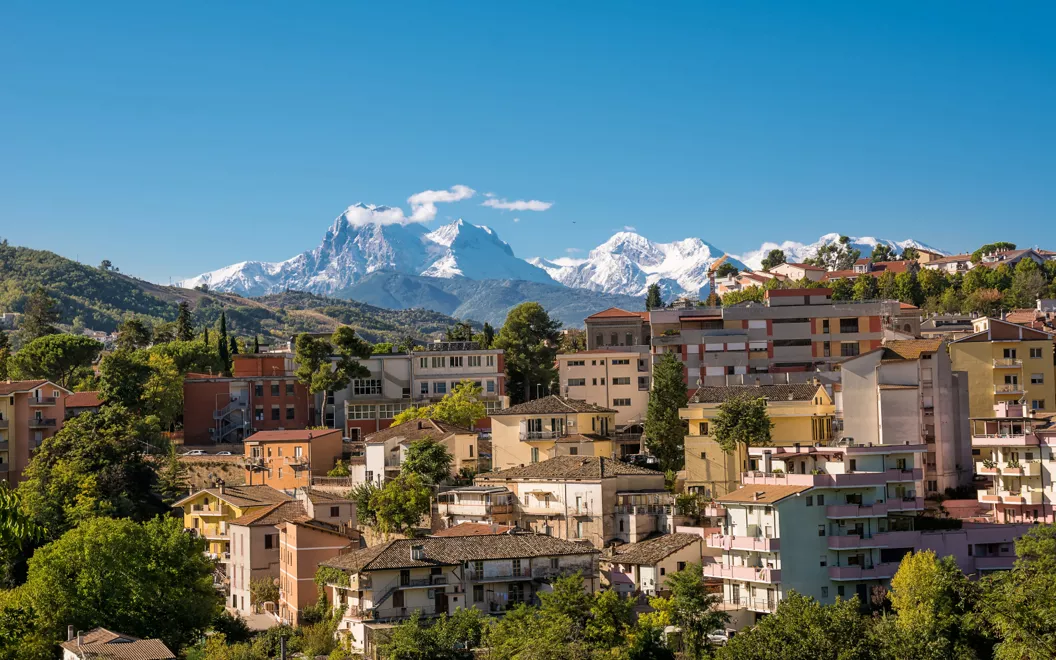Second stage of the Giro d'Italia 2023: from Teramo to San Salvo, passing through Pescara
3 minutes
Here we are in Teramo, on Sunday 7 May, for the start of the second stage of the Giro d'Italia. A city with a rich and ancient history, going all the way back to the Phoenicians. The medieval village is considered one of the most beautiful in Abruzzo.
Lying on the slopes of Gran Sasso, where the hillside falls away towards the sea, it enjoys a strategic position for visiting the area, immersed in nature, with vineyards and olive trees. The historical centre can be explored on foot and is centred around Piazza Martiri della Libertà. The piazza is lined with historical buildings from different eras and important churches, such as the Cathedral of Santa Maria Assunta, in Romanesque and Gothic style, with its instantly recognisable main façade. The historical city centre contains the remains of the Roman Amphitheatre (1st century AD) and the Roman Theatre (2nd century AD), in an excellent state of preservation.
Riding on the 'large cycling-pedestrian loop' around Teramo, you will come to the Ponte Messato archaeological site on Via Cecilia, an ancient paved Roman road, which, due to various similarities with the Appian Way, is known as the 'Appia Teramana'. Here you can visit the ancient necropolis of pre-Roman origins, a vast area containing numerous finds from different eras, which was rediscovered in the early 1960s.
Teramo is surrounded by the beautiful mountains of the Gran Sasso National Park, the highest in the Apennines, which in winter are covered with a white mantle and in summer host many interesting sports activities, aside from cycling, such as trekking, horse riding, hiking and many activities for children.
The varied food and wine tradition is favoured by the proximity to the mountains, for the quality of the cheeses and meats produced by the skilful hands of the shepherds, and to the sea, which is the exclusive source of special dishes, such as brodetto, a fish soup with a unique and delicious taste.
On the way to the cycling race we find Pescara, famous for its charming seafront and beautiful beaches with shallow waters on the Adriatic Sea, and for being the 'city of D’Annunzio', a lively yet harmonious city, ideal to visit in any season, thanks to its temperate climate. Its thousand-year history is in perfect balance with modernity, it welcomes visitors of all ages and attracts guests with different interests.
Among the buildings of historical importance is the birthplace of Gabriele d 'Annunzio, now a museum. In the centre of Old Pescara stands the Cathedral of San Cetteo, named after the city's patron saint. It was built in the 1930s at the behest of 'Il Vate' and houses a painting of San Francesco by Guercino, which was donated by d'Anunzio himself.
Walking along the promenade, you come across an expanse of beach facilities, accessible during the day and in the evening, when the numerous night spots come alive with attractions of various kinds. There is no shortage of seafront restaurants where you can sample the typical fish soup of Pescara, salted cod, or meat specialities, such as arrosticini, a typical Abruzzese dish, or Penne-style tripe, for the more daring.
The second cycling stage ends in San Salvo, a small town in the province of Chieti, the last on the Trabocchi Coast. It is a popular summer holiday destination, with a crystal-clear sea and well-maintained beaches offering facilities for a wide range of activities.
It owes its name to a benedictine monk, who was rector of the abbey in the 9th century, but its origins date back to prehistoric times, as shown by archaeological finds in the area. The Quadrilatero Archaeological Park in the historic centre houses most of the historical buildings, including the Porta della Terra Civic Museum, the Abbey Museum, the Cloister Archaeological Island, the Roman Mosaic House, the Roman Aqueduct and the Church of St Joseph, which is considered the most important monument in the city, dating from before the 13th century.
In 2000, after a large-scale reclamation project, a nature reserve called coastal biotope was established in San Salvo Marino. It is one of the few sandy strips in Abruzzo where dunes are still present, and the protected area is attached to the Mediterranean Botanical Garden of San Salvo, where you can find many species of plants that thrive in the marine ecosystem.
The area retains its rural food and wine tradition, with genuine products, such as handmade 'pasta alla chitarra', cured meats, the excellent Montepulciano d'Abruzzo and olive oil, loved and exported all over the world.
The stage podium
Chef Enrico Croatti's lamb arrosticini from Moebius for a taste of Abruzzo
Arrosticini are a traditional recipe of Abruzzo cuisine, which can also be enjoyed in a contemporary style thanks to their timeless ingredients.




